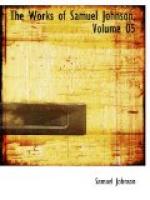ascending to the lord mayor’s, which immediately
preceded that of the queen, who was attended by the
bachelors’ or state barge, with the magnificence
of which her majesty was much delighted; and being
arrived at the Tower, she returned the lord mayor
and aldermen thanks, for the pomp with which she
had been conducted thither.
Two days after, the lord mayor, in a gown of crimson velvet, and a rich collar of SS, attended by the sheriffs, and two domestics in red and white damask, went to receive the queen at the Tower of London, whence the sheriffs returned to see that every thing was in order. The streets were just before new gravelled, from the Tower to Temple-bar, and railed in on each side, to the intent that the horses should not slide on the pavement, nor the people be hurt by the horses; within the rails near Gracechurch, stood a body of Anseatic merchants, and next to them the several corporations of the city, in their formalities, reaching to the alderman’s station at the upper end of Cheapside. On the opposite side were placed the city constables, dressed in silk and velvet, with staffs in their hands, to prevent the breaking in of the mob, or any other disturbance. On this occasion, Gracechurch street and Corn hill were hung with crimson and scarlet cloth, and the sides of the houses of a place then called Goldsmiths’ row, in Cheapside, were adorned with gold brocades, velvet, and rich tapestry.
The procession began from the Tower, with twelve of the French ambassador’s domestics in blue velvet, the trappings of their horses being blue sarsnet, interspersed with white crosses; after whom marched those of the equestrian order, two and two, followed by judges in their robes, two and two; then came the knights of the bath in violet gowns, purfled with menever. Next came the abbots, barons, bishops, earls, and marquises, in their robes, two and two.
Then the lord chancellor, followed by the Venetian ambassador and the archbishop of York; next the French ambassador and the archbishop of Canterbury, followed by two gentlemen representing the dukes of Normandy and Aquitain; after whom rode the lord mayor of London with his mace, and garter in his coat of arms; then the duke of Suffolk, lord high steward, followed by the deputy marshal of England, and all the other officers of state in their robes, carrying the symbols of their several offices: then others of the nobility in crimson velvet, and all the queen’s officers in scarlet, followed by her chancellor uncovered, who immediately preceded his mistress.
The queen was dressed in silver brocade, with a mantle of the same furred with ermine; her hair was dishevelled, and she wore a chaplet upon her head set with jewels of inestimable value. She sat in a litter covered with silver tissue, and carried by two beautiful pads cloathed in white damask, and led by her footmen. Over the litter was carried a canopy of cloth of gold,




